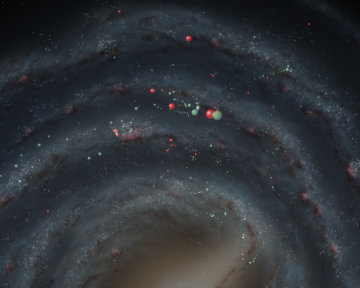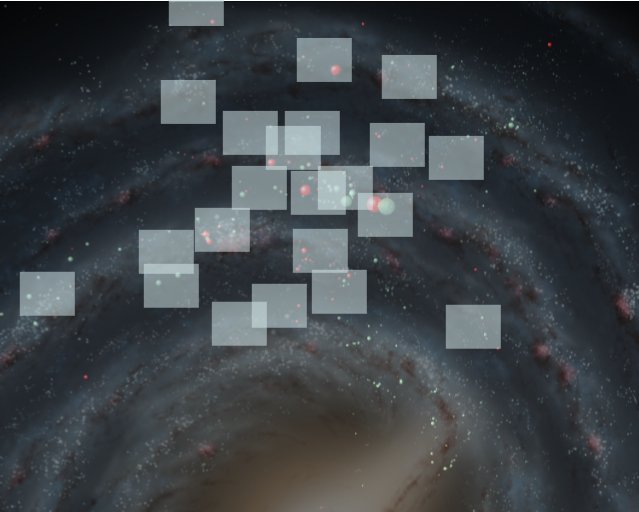 This chapter describes the face-on maps of the Milky Way available from this site. This is the view you would get if you were in a star ship hovering far above the galactic nucleus. If you would like maps of the Milky Way as seen from the Earth, visit the Milky Way Explorer.
This chapter describes the face-on maps of the Milky Way available from this site. This is the view you would get if you were in a star ship hovering far above the galactic nucleus. If you would like maps of the Milky Way as seen from the Earth, visit the Milky Way Explorer.
Read first
It is probably best to read the chapters on the basic plan of the Milky Way and the techniques that astronomers use to survey the galaxy before looking at the detailed maps.
Some caveats
The face-on maps on this site are based upon photometric and kinematic distance estimates taken from the scientific literature. As explained in Surveying the Galaxy, photometric and kinematic estimates are often incorrect. However, until recently, they were the only ones available for most of the galaxy. Much more reliable distance estimates based on parallax are now becoming available and will make far more accurate maps possible over the next decade.
The current age of galactic exploration is perhaps similar to the period a few years after Columbus arrived in the "New World". At that point most of the major continents were known by Europeans (although Australia and Antarctica were not) but maps of the world beyond Europe were incomplete and distorted. In our case, the Gould Belt region within about 500 parsecs is fairly well known. Beyond that: Here be dragons.
The maps on this site do not cover the full Milky Way. Very little data is available on the half of the galaxy on the far side of the galactic nucleus, and even on our side of the galaxy, information on objects located more than about 10 thousand parsecs (about 30 thousand light-years) from the Sun is almost non-existent. I've shown the area of the Milky Way covered by this site in the image on the right, which is derived from an artist's conception of the Milky Way released by NASA.
Even within 10 thousand parsecs, the face-on maps are incomplete in other ways. The most obvious problem is a lack of molecular clouds for the fourth galactic quadrant. No catalog of molecular clouds containing distance estimates has ever been published for this quadrant.
Molecular clouds are shown for the other galactic quadrants. However, recent research has shown that the kinematic distance estimates given in the scientific literature for these clouds are often wildly inaccurate. Beyond these clouds, most of the objects on the map are optically visible. This means that their positions may be somewhat more accurate as they are often based upon photometric estimates. However, recent infrared surveys have shown that many (and possibly most) of the Milky Way's star formation regions are embedded in thick dust clouds and are optically obscured. Moreover, many other regions of the Milky Way are blocked from our view by more local dust clouds nearer to the Sun. These optically invisible star formation regions are not currently shown on the face-on maps provided on this site. (Many can be seen through the Milky Way Explorer, however.)
Map types
There are three types of face-on maps on this site.
To view the full details, you can use this map system to zoom and pan around the map.
You can view the overview map, which shows most of the objects on the main galaxy map with the exception of some smaller star clusters and a few objects on the other side of the galaxy. It also shows the main clouds of non-ionised atomic hydrogen gas in the region.
A number of people have asked me to provide maps that fall between these two types of maps - something that provides a wider view than the 360x360 images in the zoomable map system but more detail than the overview map. To this end I've provided 1280x1024 detail maps that show the galaxy map objects in 22 locations around our galactic region. You can view these maps by clicking on the index image below. These detail maps also show the main clouds of non-ionised atomic hydrogen gas in that region.
More on the maps
The galaxy maps show the estimated distances of more than 5000 bright stars. Even the dimmest of these is more than 1200 times brighter than our Sun, and the brightest of all are more than a million times brighter than the Sun. The detail maps place yellow-green labels next to the great "beacon" stars with absolute bolometric magnitudes less than -9.5. There are about 170 such stars in the Galaxy Map database and all of them are more than 600 thousand times brighter than our Sun. The size of the star is relative to its bolometric magnitude (brightness) and the colour of the star is determined by its spectral type (temperature).
In addition to the brightest stars, the maps show the locations of all known star clusters with distance estimates.
 As described in the Sources section, the maps also include nebulae from numerous databases. All of these were originally believed to be HII regions, but subsequent research has shown than some are in fact supernova remnants, planetary nebulae, reflection nebulae, or more exotic objects. Nebulae are shown as red spheres. Also shown on the map are several thousand molecular clouds - vast cold regions of dust and gas that are the birth places of most stars. Molecular clouds are shown as green spheres.
As described in the Sources section, the maps also include nebulae from numerous databases. All of these were originally believed to be HII regions, but subsequent research has shown than some are in fact supernova remnants, planetary nebulae, reflection nebulae, or more exotic objects. Nebulae are shown as red spheres. Also shown on the map are several thousand molecular clouds - vast cold regions of dust and gas that are the birth places of most stars. Molecular clouds are shown as green spheres.
You can hover your mouse over each object on the maps (whether labeled or not) to get information about that object, and click on the object to see what additional information is available.
The NASA artist's conceptual image of the Milky Way is not intended to be accurate in any detail, and in fact overlaying the data from this site on the NASA image reveals many discrepancies as you can see in the image on the left (as well as in this more detailed image here). As just one example, the area of the very bright Cygnus X region appears as an inter-arm void on the NASA image. Nevertheless, it gives a general sense of roughly where major objects on the map would appear on a traditional model of the Milky Way.
Detail map index
You can click the image map below to view any of the 22 detail maps.

